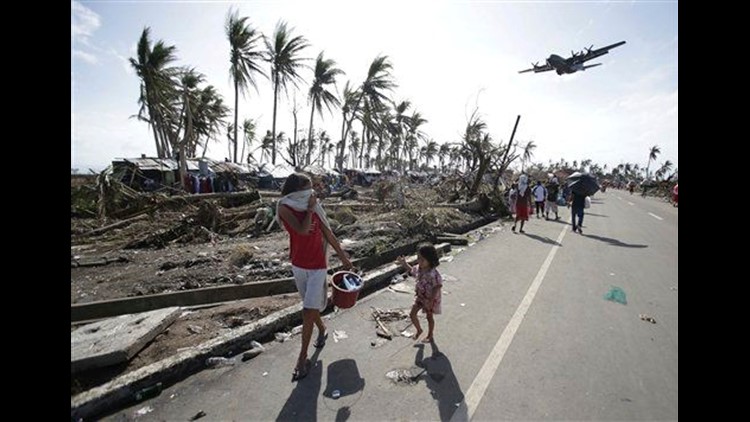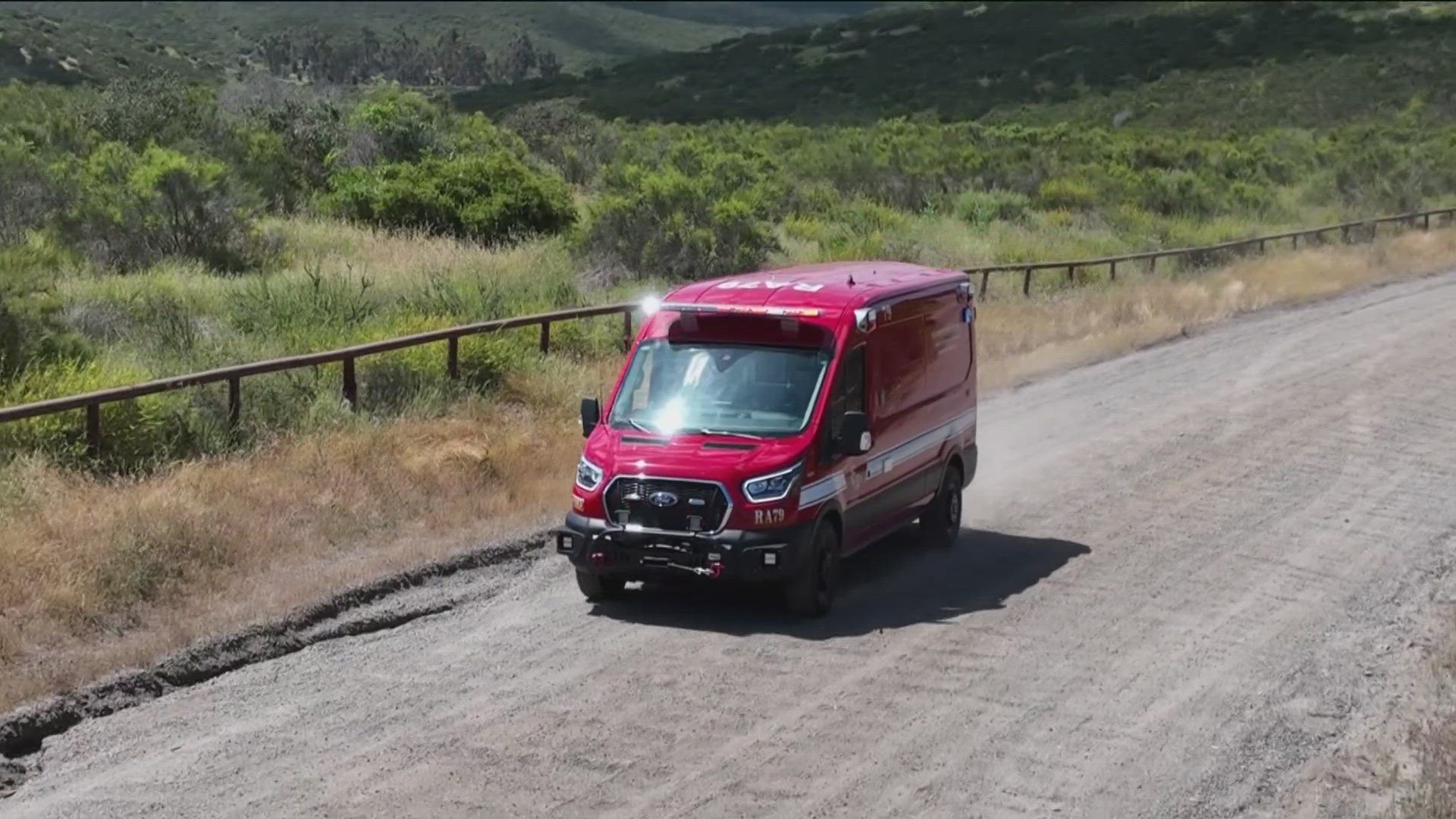Foreign governments and agencies have announced a major relief effort to help victims of the Philippine typhoon. Here are some of the pledges they have made:
UNITED STATES
U.S. Secretary of State John Kerry said he assured Philippine Foreign Minister Albert del Rosario "of our full commitment to providing all necessary assistance."
He said the U.S. government is organizing emergency shipments of critically needed material to provide shelter to the hundreds of thousands of displaced Filipinos and food and hygiene supplies to thousands of families.
Acting U.S. Ambassador Brian Goldbeck issued a disaster declaration to provide an immediate $100,000 for relief efforts. Officials from the U.S. Agency for International Development are deployed around the country to monitor the damage.
___
BRITAIN
The United Kingdom is deploying a Royal Navy warship and donating a total of 10 million pounds' (roughly $16 million) worth of humanitarian assistance in aid of the victims of the typhoon, British Prime Minister David Cameron said.
Britain will also deploy Royal Air Force military transport aircraft in aid of recovery efforts, earmarking at least one C-17 cargo plane to move humanitarian aid and large equipment.
____
AUSTRALIA
Australia announced assistance of 10 million Australian dollars ($9.4 million). That includes the deployment of an emergency medical team, aid to the U.N. Flash Appeal and aid to Australian non-governmental organizations for immediate life-saving assistance.
___
UNITED NATIONS WORLD FOOD PROGRAM
The United Nations World Food Program said it has allocated $2 million for the disaster response and officials joined an assessment mission to survey damage in Leyte and Samar provinces.
WFP said it will send more than 40 tons of high energy biscuits and work with the Filipino government to help with logistics and emergency communications systems. It asks for donations at www.wfpusa.org.
___
UNICEF
UNICEF said its staff in the Philippines is being repositioned to help in relief efforts and 66 tons of emergency supplies are being sent from Copenhagen. An airlift set to arrive on Tuesday will include water purification systems, storage equipment and sanitation supplies. Donations can be made to UNICEF at unicef.org/support.
___
JAPAN
Japan will fly a 25-member relief team of mostly medical staff.
___
TAIWAN
Taiwan said it will send $200,000 in aid to help with relief efforts.
___
RED CROSS
The American Red Cross said it has deployed two people to assist with assessments in the Philippines and activated its family tracing services. It asked those who want to support relief efforts to mail a check to their local Red Cross chapter, with "Philippines Typhoons and Flood" in the memo line.
___
WORLD VISION
World Vision said it is putting together resources to assist 1.2 million people, including food, hygiene kits, emergency shelter and protection. It asked for one-time donations to be made at worldvision.org.
___
AMERICAN JEWISH JOINT DISTRIBUTION COMMITTEE
The American Jewish Joint Distribution Committee has begun collecting donations for relief efforts. To contribute, go to www.jdc.org.
___
MERCY CORPS
Mercy Corps said it has launched emergency response efforts to provide food, water, shelter and basic supplies to typhoon survivors. To contribute, go to www.mercycorps.org/typhoon.
___
AMERICARES
AmeriCares is preparing to deploy an emergency response team to the Philippines. To donate go to http://americares.org.
___
INTERNATIONAL RESCUE COMMITTEE
The International Rescue Committee has dispatched an emergency team to Manila and launched a $10 million appeal. The IRC will work to determine which of its areas of expertise — from water and sanitation to education — are most needed.
___
DOCTORS WITHOUT BORDERS
Doctors Without Borders said it has 15 members in Cebu city and will send an additional 50 people in the next few days. It said it also is sending 329 tons of medical and relief supplies on three cargo planes. To donate, go to www.doctorswithoutborders.org/donate .
___
LUTHERAN WORLD RELIEF
Lutheran World Relief said it has deployed its local staff to stricken areas and is appealing for $2.5 million to aid its recovery effort. To donate, go to http://lwr.org/donate/
___
AMERICAN JEWISH WORLD SERVICE
American Jewish World Service is collecting money to provide directly to local groups in the Philippines. To donate, go to http://www.ajws.org.
Copyright 2013 The Associated Press. All rights reserved. This material may not be published, broadcast, rewritten or redistributed.
to preserve them.
Two officials said Sunday that Friday's typhoon may have killed 10,000 or more people, but with the slow pace of recovery, the official death toll remained well below that. The Philippine military confirmed 942 dead, but shattered communications, transportation links and local governments suggest the final toll is days away. Presidential spokesman Edwin Lacierda said "we pray" that the death toll is less than 10,000.
Tacloban resembled a garbage dump from the air, punctuated only by a few concrete buildings that remained standing.
"I don't believe there is a single structure that is not destroyed or severely damaged in some way — every single building, every single house," U.S. Marine Brig. Gen. Paul Kennedy said after taking a helicopter flight over the city. He spoke on the tarmac at the airport, where two Marine C-130 cargo planes were parked, engines running, unloading supplies.
Authorities said at least 9.7 million people in 41 provinces were affected by the typhoon, which is called Yolanda in the Philippines but is known as Haiyan elsewhere in Asia. It's one of the most powerful recorded typhoons to ever hit land and likely the deadliest natural disaster to beset this poor Southeast Asian nation.
Philippine soldiers were distributing food and water in Tacloban, and assessment teams from the United Nations and other international agencies were seen for the first time. The U.S. military dispatched food, water, generators and a contingent of Marines to the city, the first outside help in what will swell into a major international relief mission.
"Please tell my family I'm alive," said Erika Mae Karakot, a survivor on Tacloban's Leyte island, as she lined up for aid. "We need water and medicine because a lot of the people we are with are wounded. Some are suffering from diarrhea and dehydration due to shortage of food and water."
Authorities said they had evacuated some 800,000 people ahead of the typhoon, but some of the evacuation centers proved to be no protection against the wind and rising water. The Philippine National Red Cross, responsible for warning the region and giving advice, said people were not prepared for a storm surge.
"Imagine America, which was prepared and very rich, still had a lot of challenges at the time of Hurricane Katrina, but what we had was three times more than what they received," said Gwendolyn Pang, the group's executive director.
Emily Ortega, 21 and about to give birth, was among those who had thought she was safe. But the evacuation center she had fled to was devastated by the 6-meter (20-foot) storm surge, and she had to swim and cling to a post to survive. She reached safety at the airport, where she gave birth to a baby girl. Bea Joy Sagales appeared in good health, and her arrival drew applause from others in the airport and military medics who assisted in the delivery.
The winds, rains and coastal storm surges transformed neighborhoods into twisted piles of debris, blocking roads and trapping decomposing bodies underneath. Ships were tossed inland, cars and trucks swept out to sea and bridges and ports washed away.
"In some cases the devastation has been total," said Secretary to the Cabinet Rene Almendras.
Residents have stripped malls, shops and homes of food, water and consumer goods. Officials said some of the looting smacked of desperation but in other cases items taken included TVs, refrigerators, Christmas trees and a treadmill. An Associated Press reporter in the town said he saw around 400 special forces and soldiers patrolling downtown to guard against further chaos.
Brig. Gen. Kennedy said Philippine forces were handling security well, and that his forces were "looking at how to open up roads and land planes and helicopters. We got shelter coming in. (The U.S. Agency for International Development) is bringing in water and supplies."
Those caught in the storm were worried that aid would not arrive soon enough.
"We're afraid that it's going to get dangerous in town because relief goods are trickling in very slow," said Bobbie Womack, an American missionary and longtime Tacloban resident from Athens, Tennessee. "I know it's a massive, massive undertaking to try to feed a town of over 150,000 people. They need to bring in shiploads of food."
Womack's husband, Larry, said he chose to stay at their beachside home, only to find the storm surge engulfing it. He survived by climbing onto a beam in the roof that stayed attached to a wall.
"The roof was lifting up and the wind was coming through and there were actual waves going over my head," he said. "The sound was loud. It was just incredible."
Marvin Daga, a 19-year-old student in Tacloban, tried to ride out the storm in his home with his ailing father, Mario, but the storm surge carried the building away.
They clung to each other while the house floated for a while, but it eventually crumbled and they fell into churning waters. Marvin grabbed a coconut tree with one hand and his father with the other, but Mario slipped out of his grasp and sank.
"I hope that he survived," Marvin said in an army medic room as tears filled his eyes. "But I'm not expecting to find him anymore."
Philippine President Benigno Aquino III said in a statement he had a declared a "state of national calamity" allowing the central government to release emergency funds quicker and impose price controls on staple goods. He said the two worst-hit provinces, Leyte and Samar, had witnessed "massive destruction and loss of life" but that elsewhere casualties were low.
Haiyan hit the eastern seaboard of the Philippines on Friday and quickly barreled across its central islands, packing winds of 235 kph (147 mph) that gusted to 275 kph (170 mph). It inflicted serious damage to at least six islands in the middle of the eastern seaboard.
The storm's sustained winds weakened to 120 kph (74 mph) as the typhoon made landfall in northern Vietnam early Monday after crossing the South China Sea, according to the Hong Kong meteorological observatory. Authorities there evacuated hundreds of thousands of people, but there were no reports of significant damage or injuries.
It was downgraded to a tropical storm as it entered southern China later Monday, and weather officials forecast torrential rain in the area until Tuesday. No major damage was reported in China, though Xinhua News Agency said heavy winds tore a cargo ship from its moorings in southern China and drove it out to sea, killing at least two crew members.
The Philippines, an archipelago nation of more than 7,000 islands, is annually buffeted by tropical storms and typhoons, which are called hurricanes and cyclones elsewhere. The impoverished and densely populated nation of 96 million people is in the northwestern Pacific, right in the path of the world's No. 1 typhoon generator, according to meteorologists. The archipelago's exposed eastern seaboard often bears the brunt.
Even by the standards of the Philippines, however, Haiyan was an especially large catastrophe. Its winds were among the strongest ever recorded, and it appears to have killed more people than the previous deadliest Philippine storm, Thelma, in which about 5,100 people died in the central Philippines in 1991.
The country's deadliest disaster on record was the 1976 magnitude-7.9 earthquake that triggered a tsunami in the Moro Gulf in the southern Philippines, killing 5,791 people.
___
Associated Press writers Oliver Teves and Teresa Cerojano in Manila and Minh Tran in Hanoi, Vietnam, contributed to this report.
Copyright 2013 The Associated Press. All rights reserved. This material may not be published, broadcast, rewritten or redistributed.



